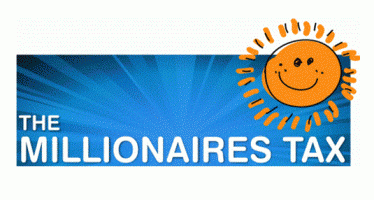Budget rule hides where Prop. 30 and Prop. 39 taxes will be spent
By Wayne Lusvardi
A little known new accounting rule buried in the fiscal 2012-13 California state budget now will make it virtually impossible for the public to track where and when the tax revenues from Propositions 30 and 39 will be spent. Prop. 30 is Gov. Jerry Brown’s $6 billion tax increase. And Prop. 39 is hedge fund manager Thomas Steyer’s $1 billion tax increase. Both propositions were passed by voters on Nov. 6.
The new budget rule is Section 35.50 of the Budget Act of 2011-12, also known as Assembly Bill 1495. The new rule authorizes a shift from cash (actual) accounting to an accrual (projected) accounting method. What this murky rule means is that budget revenues from two years can be applied to one year’s worth of expenses. The result will be an inflated and non-transparent budget.
The key part of the new rule vaguely says: “The net final payment accrual methodology shall be implemented with regard to any change in state law which is enacted during 2012.” The changes to state tax law in 2012 are Props. 30 and 39.
LAO Says Budget Forecasts Will Now Be Error Prone
The newly-released report prepared by the state Legislative Analyst’s Office, “The 2013-14 Budget: California’s Fiscal Outlook,” contains the following description of the new rule:
“Section 35.50 of the 2012–13 Budget Act institutes a new accrual method for the tax revenues generated by Propositions 30 and 39. A portion of final income tax payments paid in, say, April of one year will be accrued all the way back to the prior fiscal year (which ended ten months in the past). One effect of the change is that we will no longer have a good idea of a fiscal year’s revenues until one or two years after that fiscal year’s conclusion. Because the volatile capital gains-related revenues from Proposition 30 are the subject of the accrual changes, the late adjustments to revenues could total billions of dollars—much more than in the past. As a result, the chances of large forecast errors by us and the administration will increase.”
The Legislative Analyst’s Office also elaborated on the problems involved with this new rule:
“We are now convinced that the problems that this new accrual method will introduce to the budgetary process outweigh its benefits. We recommend that the Legislature direct the administration to develop a simpler, logical budgetary revenue accrual system by 2015. Alternatively, to help ensure the accuracy of our forecasts and improve transparency, we recommend that the Legislature require the administration to document accruals regularly online.”
In other words, the LAO is saying that even its impartial budget numbers will be unreliable because it will be impossible to track budget accruals and compare them with the actual cash status of the budget.
Cash Versus Accrual Accounting
The new rule involves what is called the accrual basis of accounting. According to the glossary contained in the 2012-13 State Budget, the accrual basis of accounting is defined:
“The basis of accounting in which revenue is recorded when earned and expenditures are recorded when obligated, regardless of when the cash is received or paid.”
In cash-based accounting, the record of expenses is recorded when the cash is actually laid out. In contrast, under accrual based accounting, revenue or expenses are recorded when the transaction is completed, not when it receives the cash or when it pays for supplies.
For example, even though the customer may not have paid the final bill yet, a carpenter records receiving payment when the job is completed. Or a carpenter buys materials on his account at Home Depot, not when he actually pays cash for the lumber maybe a month afterward.
“Trust Us” Budget Accounting
In other words, from now until 2019, when Prop. 30 expires, it will be impossible to know whether the budget figures released by the state are the actual numbers. California’s budget accountability to the public will turn into a secretive game of “trust us.”
This new budget rule signals that it is unlikely the taxes generated from Prop. 30 will be spent on public schools, as advertised by Brown. And the revenues from Prop. 39 likely will be siphoned into CalPERS’s pension fund.
How do we know this? We don’t know for sure because where the funds are eventually to be spent is intentionally left open-ended and vague. But it can now be surmised that Brown will use Prop. 30’s tax revenues to patch shortfalls in other items in the general fund budget, such as Medi-Cal. And an educated guess is that the tax revenues from Prop. 39 will go to CalPERS’ pension fund.
The effect of the new budget accounting method will be to count two years’ worth of revenue and only one year’s worth of expenses to create an appearance of a balanced budget and rising revenues. Based on an inflated assumption of rising revenues, it follows that legislators can then plan on higher spending as well.
Surplus Forecast Counts Two Birds in a Bush
The Legislative Analyst’s new budget outlook for 2013-2018 forecasts budget surpluses of $1 billion or more starting in 2014, up to nearly $10 billion in 2018. Some newspapers are already reporting these surpluses without disclosing the risky and rigged assumptions on which they are based.
But Californians need to understand that budget estimates are no more reliable than their assumptions. And a key assumption the Legislative Analyst is forced to use is presuming the availability of two years’ worth revenues to apply to one year’s worth of expenses.
In other words the budget is based on counting the proverbial two birds in the bush rather than the one bird in hand. This results in an inflated forecast of budget surpluses.
This new budget rule is the result of one-party rule in California. Redistricting and supermajority rule by Democrats in the Legislature may result in more moderate candidates who are more favorable to increasing taxes. But an unintended consequence of one party rule is that the status of the state general fund budget is more likely to be inflated and partly hidden.
Related Articles
GOP Finally Gets Budget Action
MARCH 26, 2011 By JOHN SEILER There are a lot of problems with the list of budget demands Republicans proposed,
CA doing 'everything wrong'
APRIL 8, 2010 By JOHN SEILER A book released April 7, 2010 ranks California among the “States That Do Everything
Top 5 taxes you may see on the 2016 ballot
Last June, I wrote a column forecasting which tax increase measures might be on the Nov. 2016 ballot given the




